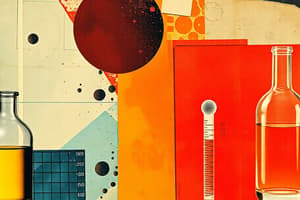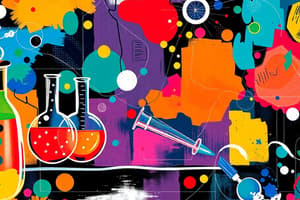Podcast
Questions and Answers
In the scientific method, what is the primary purpose of conducting an experiment?
In the scientific method, what is the primary purpose of conducting an experiment?
- To ensure the constants remain unchanged throughout the entire process.
- To prove that the initial hypothesis is correct beyond any doubt.
- To formulate a new question for further investigation.
- To gather evidence that either supports or contradicts a prediction. (correct)
A researcher observes that plants grow taller when exposed to sunlight. If she designs an experiment to test this, what would be the most appropriate hypothesis?
A researcher observes that plants grow taller when exposed to sunlight. If she designs an experiment to test this, what would be the most appropriate hypothesis?
- The type of soil is the only factor affecting plant growth.
- Plants require sunlight to grow, and the amount of sunlight affects their height. (correct)
- Sunlight has no measurable effect on plant growth.
- All plants grow at the same rate regardless of environmental factors.
What role do constants play in a well-designed scientific experiment?
What role do constants play in a well-designed scientific experiment?
- Constants are features you change in the experiment.
- Constants are only relevant in theoretical, not practical, experiments.
- Constants are what the scientist measures in the experiment.
- Constants minimize external factors that could influence the dependent variable. (correct)
In an experiment studying the effect of a new fertilizer on plant growth, what represents the independent variable?
In an experiment studying the effect of a new fertilizer on plant growth, what represents the independent variable?
A student conducts an experiment to see how temperature affects the dissolving rate of sugar in water. What represents the dependent variable?
A student conducts an experiment to see how temperature affects the dissolving rate of sugar in water. What represents the dependent variable?
After completing an experiment, a scientist analyzes the data but finds that it contradicts the initial hypothesis. According to the scientific method, what is the most logical next step?
After completing an experiment, a scientist analyzes the data but finds that it contradicts the initial hypothesis. According to the scientific method, what is the most logical next step?
Which of the following best describes the role of 'research' as a step within the scientific method?
Which of the following best describes the role of 'research' as a step within the scientific method?
What is the significance of 'spreading the word' or publishing results in the scientific method?
What is the significance of 'spreading the word' or publishing results in the scientific method?
What is the most important factor when interpreting data collected during an experiment?
What is the most important factor when interpreting data collected during an experiment?
A scientist wants to test the effectiveness of a new drug on reducing blood pressure. He divides participants into two groups: one receives the drug, and the other receives a placebo. What type of variable represents the group assignment (drug vs. placebo)?
A scientist wants to test the effectiveness of a new drug on reducing blood pressure. He divides participants into two groups: one receives the drug, and the other receives a placebo. What type of variable represents the group assignment (drug vs. placebo)?
In an experiment designed to test the effect of fertilizer concentration on plant growth, which of the following represents a controlled variable?
In an experiment designed to test the effect of fertilizer concentration on plant growth, which of the following represents a controlled variable?
When analyzing a timeline depicting the evolution of transportation, what is the first step to understanding the information presented?
When analyzing a timeline depicting the evolution of transportation, what is the first step to understanding the information presented?
During the engineering design process, after identifying a problem and conducting initial research, what is the subsequent step?
During the engineering design process, after identifying a problem and conducting initial research, what is the subsequent step?
Considering the structure of an atom, which statement accurately describes the relationship between its components?
Considering the structure of an atom, which statement accurately describes the relationship between its components?
Why are valence electrons significant in determining the chemical behavior of an atom?
Why are valence electrons significant in determining the chemical behavior of an atom?
What distinguishes a molecule from an atom?
What distinguishes a molecule from an atom?
Which statement best describes the key difference between a molecule and a compound?
Which statement best describes the key difference between a molecule and a compound?
How are elements, molecules, and compounds related in terms of their composition?
How are elements, molecules, and compounds related in terms of their composition?
On the periodic table, what information can be quickly obtained about an element?
On the periodic table, what information can be quickly obtained about an element?
Which group of elements is commonly found in organic molecules that compose living things?
Which group of elements is commonly found in organic molecules that compose living things?
Flashcards
Controlled Variables
Controlled Variables
Features kept the same throughout an experiment.
Valid Experiment Controls
Valid Experiment Controls
Standards used to assess the validity of an experiment.
Timeline
Timeline
A way to show events in chronological order.
Engineering Design Process
Engineering Design Process
Signup and view all the flashcards
Atom
Atom
Signup and view all the flashcards
Electrons
Electrons
Signup and view all the flashcards
Valence Electrons
Valence Electrons
Signup and view all the flashcards
Molecule
Molecule
Signup and view all the flashcards
Compound vs Molecule
Compound vs Molecule
Signup and view all the flashcards
Periodic Table
Periodic Table
Signup and view all the flashcards
Scientific Method
Scientific Method
Signup and view all the flashcards
Ask a Question
Ask a Question
Signup and view all the flashcards
Research
Research
Signup and view all the flashcards
Hypothesis
Hypothesis
Signup and view all the flashcards
Independent Variable
Independent Variable
Signup and view all the flashcards
Dependent Variable
Dependent Variable
Signup and view all the flashcards
Constants
Constants
Signup and view all the flashcards
Results
Results
Signup and view all the flashcards
Conclusion
Conclusion
Signup and view all the flashcards
Variables
Variables
Signup and view all the flashcards
Study Notes
Scientific Method
- A set of steps to ensure scientific work is done correctly.
- Steps (processes) involved:
- Ask a question.
- Research the question.
- Make a prediction (guess).
- Experiment: collect evidence/measurements to answer the question.
- Collect results (data).
- Share results/start again (if results don't align with predictions, predict again and experiment differently).
Experimental Design
- Experiments use the scientific method to test ideas.
- Components of an experiment:
- Clear question.
- Hypothesis: statement about what will happen based on past observations.
- Constants: factors kept the same to avoid affecting results.
- Independent variable: factor changed by the experimenter.
- Dependent variable: factor measured as a result of the independent variable.
- Conclusion: states whether the hypothesis was correct based on experimental results.
Interpreting Data
- Scientific evidence is all data collected during an experiment.
- To interpret data, check if it answers the question and supports the hypothesis.
- If data aligns with the hypothesis, interpret it accordingly.
Types of Variables
- Independent variable: changed factor in an experiment.
- Dependent variable: measured outcome of the experiment.
- Controlled variables: factors kept constant throughout the experiment.
- Controls: standards to assess experimental validity.
Timelines
- Display events in chronological order.
- Examine the title to identify the topic.
- Note the time periods shown (days, months, years, decades, centuries).
Engineering Design Process
- Series of steps for solving problems.
- Steps include:
- Ask
- Research
- Imagine
- Select & Plan
- Create
- Test & Evaluate
- Improve
Atoms
- Basic building blocks of matter.
- Composed of:
- Nucleus (center): made of protons and neutrons.
- Electrons: orbit the nucleus.
Electrons
- Negatively charged particles.
- Involved in electrical currents and bonding atoms.
- Number of electrons varies between elements.
Valence Electrons
- Electrons in the outermost shell (energy level) of an atom.
- Crucial for determining element combinations.
- Periodic table helps predict valence electron count (except for groups 3-12).
- Atoms strive for a full valence electron shell (8 is a common goal).
Molecules
- Groups of two or more atoms chemically bonded.
- Size and shape depend on the types and number of atoms.
Elements vs. Molecules vs. Compounds
- Elements consist of a single type of atom and cannot be broken down.
- Molecules are groups of atoms bonded together (can be the same or different atoms).
- Compounds are molecules made of different types of atoms.
- Molecules can be classified as ionic or covalent compounds.
- Pure substances contain only one type of compound or element.
- Mixtures contain two or more compounds or elements not chemically bonded.
Elements and the Periodic Table
- Elements are substances not further divisible.
- Periodic table organizes elements:
- Element name
- Atomic number (number of protons).
- Symbol.
- Atomic mass.
- Category (metal, nonmetal, metalloid).
- Arrangement in periodic table helps determine basic element properties.
- Lightest elements are Hydrogen and Helium.
Important elements used in organic molecules are Hydrogen, Carbon, Nitrogen, Oxygen Some important metals: Sodium, Gold, Silver, Iron, Copper, Aluminum Chlorine (Cl) is in table salt and Silicon (Si) is a metalloid used in various products.
Studying That Suits You
Use AI to generate personalized quizzes and flashcards to suit your learning preferences.




